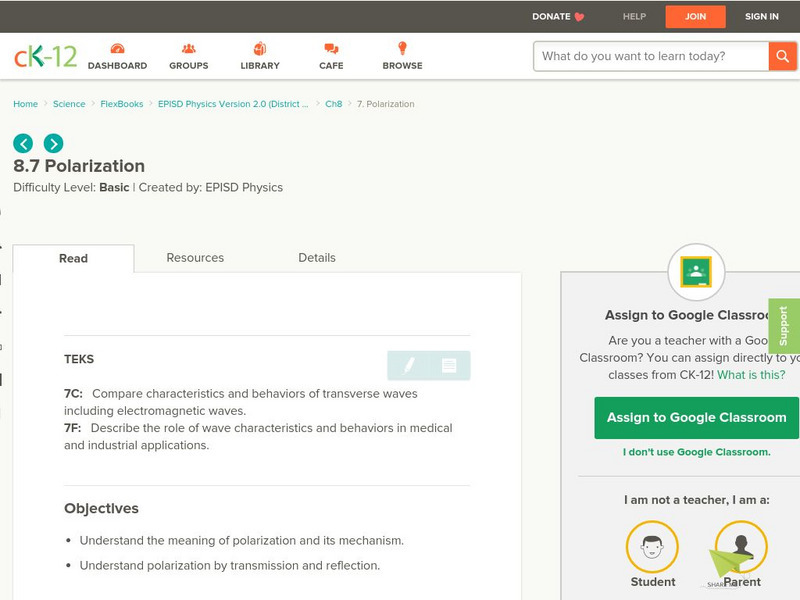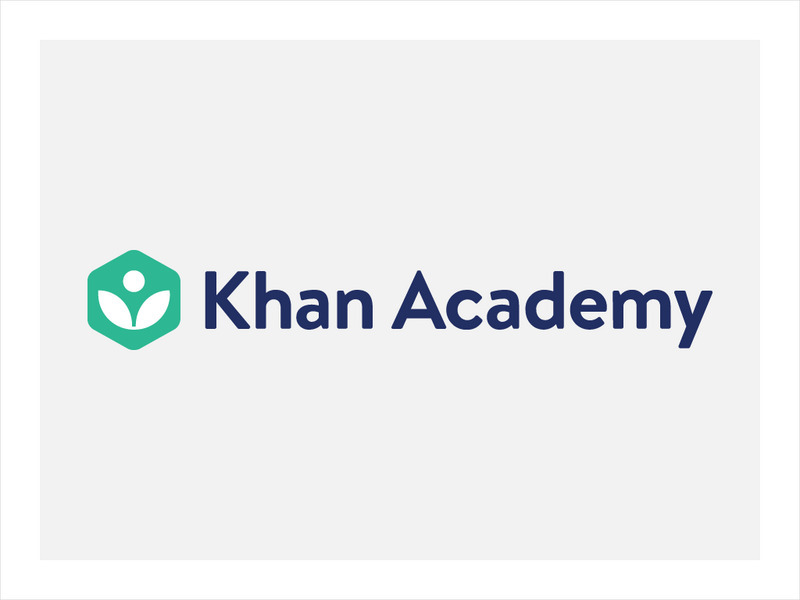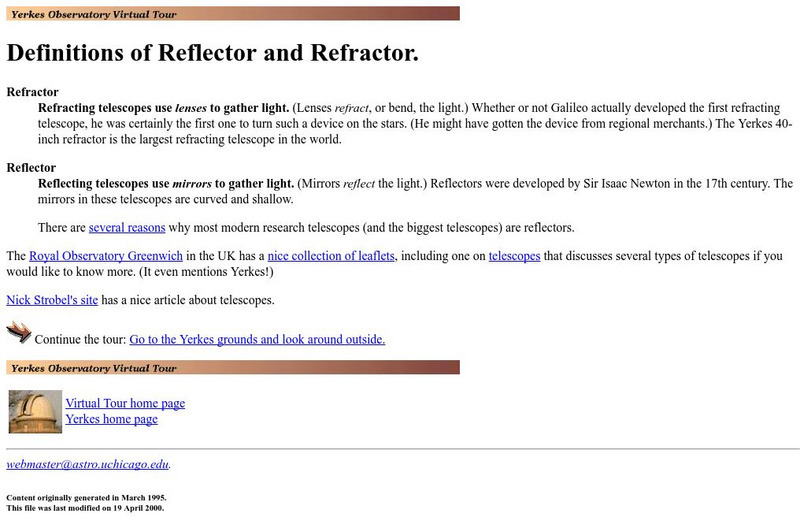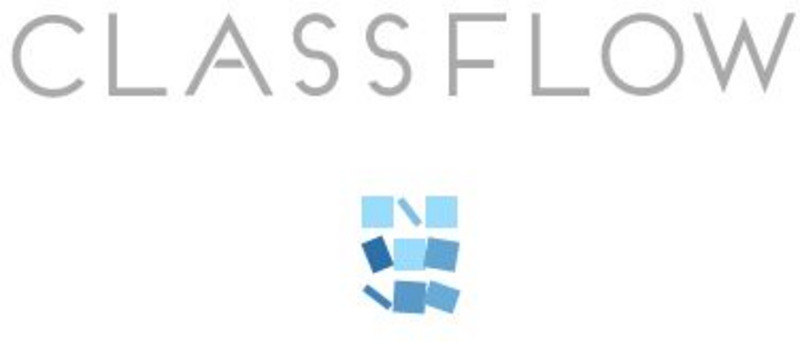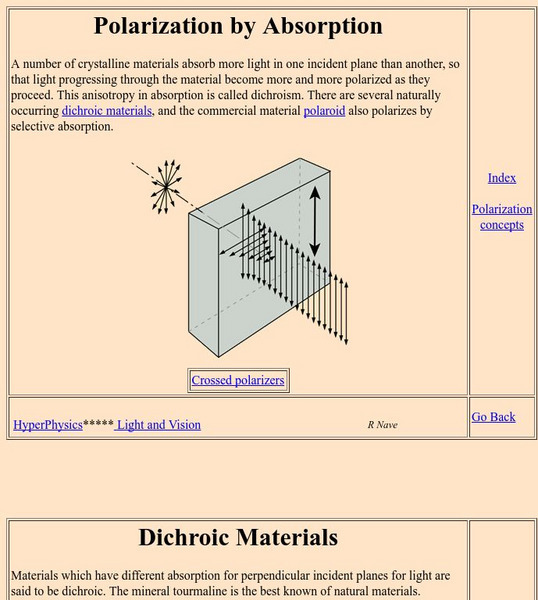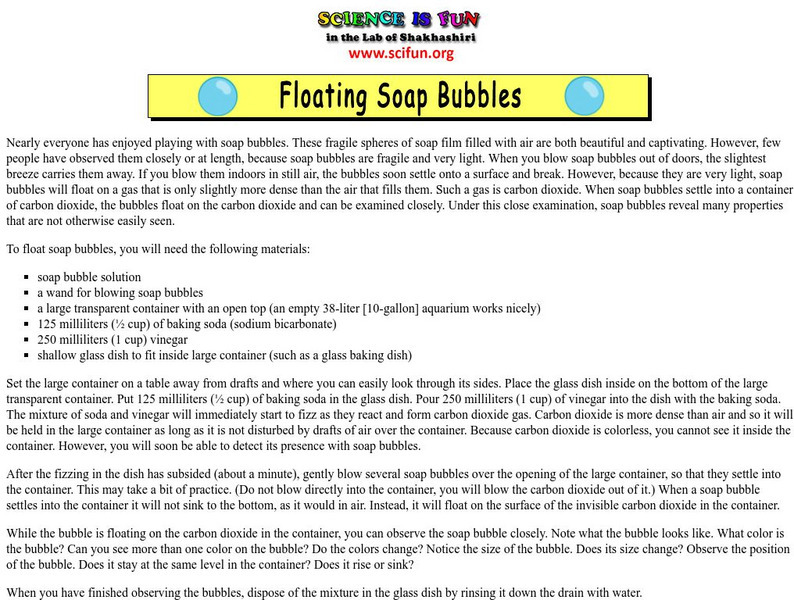Physics Classroom
The Physics Classroom: Reflection/ray Model of Light: The Mirror Equation Convex
While a ray diagram may help one determine the approximate location and size of the image, it will not provide numerical information about image distance and image size. To obtain this, students are introduced to the Mirror Equation and...
PBS
Pbs Learning Media: What Is Albedo?
When light strikes an object it can cause reflection or absorption depending on the wavelength of the light and the property of the material that makes up the object. Watch this whiteboard animation for a full explanation and to find out...
Georgia Department of Education
Ga Virtual Learning: Geometric Optics
This interactive unit will help students to understand the basics of geometric optics. Learn what happens when light strikes the boundary between two media as well as the difference between a real and virtual image? Also explore the law...
Physics Classroom
The Physics Classroom: Lesson 3: Concave Mirrors
Lesson 3 of this tutorial on refraction is on concave mirrors. Content that is covered includes the anatomy of curved mirrors, reflection of light and image formation, ray diagrams, image characteristics for concave mirrors, plus more.
PBS
Pbs Learning Media: Laser Waterfall
In this video from the Encyclopedia of Physics Demonstrations, students will observe how a laser beam is trapped in a water jet because the light reflects against the surface of the water. [1:03]
TeachEngineering
Teach Engineering: Make That Invisible! Refractive Index Matching
Students determine the refractive index of a liquid with a simple technique using a semi-circular hollow block. Then they predict the refractive index of a material (a Pyrex glass tube) by matching it with the known refractive index of a...
CK-12 Foundation
Ck 12: Polarization
[Free Registration/Login may be required to access all resource tools.] Students understand the meaning of polarization and its mechanism and polarization by transmission and reflection.
CK-12 Foundation
Ck 12 Exploration Series: Simulations: Physics: Diamond Cut
[Free Registration/Login Required] A simulation investigating why a diamond shines by looking at refraction, reflection, and total internal reflection.
TeachEngineering
Teach Engineering: Construct It!
Students use simple household materials, such as PVC piping and compact mirrors, to construct models of laser-based security systems. The protected object (a "mummified troll" or another treasure of your choosing) is placed "on display"...
BBC
Bbc: Gcse Bitesize: General Properties of Waves
Light travels as waves. Waves can be described by their amplitude, wavelength and frequency. The speed of a wave can be calculated from its frequency and wavelength.
Optical Society
Optical Society of America: Optics for Kids: Mirror, Mirror on the Wall
A simple experiment that clearly demonstrates angles of reflection when light hits a mirror. Accompanied by a good explanation of what's happening, and a link to an article on reflection.
Khan Academy
Khan Academy: Eye Disease and Contact Lenses
Punctate keratitis is an eye disease that results in abrasions on the epithelial cornea. One of the leading causes of the disease is the overuse of contact lenses. A research team is investigating the optical properties of four new types...
Physics Classroom
The Physics Classroom: Blue Skies and Red Sunsets
This high school resource shows how the blue of the skies and the red of the sunsets can be explained by the interaction of sunlight with atmospheric particles which causes scattering of light.
Other
Escolar.com: La Luz
A brief summary and illustrations of light and how the lights rays are reflected and bent.
University of Chicago
University of Chicago: Reflector and Refractor
From the Yerkes Observatory Virtual Tour web site. Compares and contrasts reflecting and refracting telescopes. A link from the page leads to a second page which explains why most modern research telescopes are reflecting telescopes.
ClassFlow
Class Flow: How We See Things
[Free Registration/Login Required] In this unit children learn that mirrors and shiny surfaces alter the direction in which light travels and that when they see objects light enters the eye. Children contrast reflection and shadow...
PBS
Pbs Learning Media: Earth's Albedo and Global Warming
In this interactive activity adapted from NASA and the U.S. Geological Survey, learn about Earth's albedo (the ratio of reflected vs. incident solar radiation), how pollution alters albedo, and how ice-albedo feedback may accelerate...
Georgia State University
Georgia State University: Hyper Physics: Polarization by Absorption
The operation of Polaroid filters on a pair of sunglasses is shown.
Georgia Department of Education
Ga Virtual Learning: Optics
Students discover how mirrors affect optics in this module through reading informational text, watching animations, and answering self-checking practice questions.
Space Telescope Science Institute
Amazing Space: Telescopes From the Ground Up
Students can investigate the historical development of six different telescopes. The technical aspects of different telescopes are also presented.
TeachEngineering
Teach Engineering: When Silicon Talks
In this activity, students tackle this aspect of engineering as they solve problems for precise angles and speeds, and predict data output when samples are altered.
My Science Site
Mirrors, Lenses and Your Eyes
This resource explores the science behind light and how mirrors reflect it. Also contains information on lenses both convex and concave.
Science is Fun
Science Is Fun: Floating Soap Bubbles
In this experiment you learn how to generate carbon dioxide inside a container, and float soap bubbles above the gas. Once the bubbles are suspended, it is possible to observe them closely, which is normally very difficult to do....
Texas Instruments
Texas Instruments: Finding the Shortest Path
Students discover the shortest distance light travels from an object to the human eye, as the light from the object reflects off a single mirror. In the process they learn about reflection in a line, congruent angles, angle bisectors,...
Other popular searches
- Light Reflection Refraction
- Reflection of Light
- Light Reflection Mirrors
- Light Reflection by Mirror
- Science Light Reflection
- Light Reflection and Color
- Reflection Light
- Light Reflection and Mirrors
- Light Reflection Projects
- "Reflection" Light
- Light Reflection Internet
- Reflection of Light Waves





